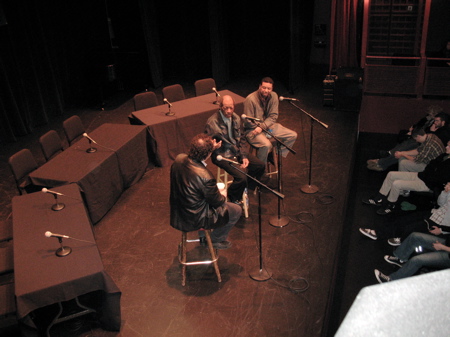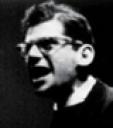I tried to keep up with Ornette Coleman’s onstage conversation Friday with jazz writer/historian Howard Mandel, one of the many Portland Jazz Festival activities this week.
It wasn’t easy. Was what he was saying at any given time actually making sense? Was there a thread to his interview, a philosophy embedded somehow? Was he answering the questions, or questioning the answers? Was he here with us, and if so, could I remember enough of what he said, once I’d figured out what it was, to record it in my notebook? Ornette, you are one tough cookie to convert to print. And the heroic Mandel was by turns bewildered and frustrated as he attempted to corral Ornette’s responses into something the rational mind might contemplate without throwing up its hands.

As I was squeezing the things that made sense out of my notes and reciting them to Marty Hughley, longtime arts writer for The Oregonian (after Ornette’s evening concert but before the SFJazz Collective played Friday night), a music fan behind us piped up: “I can’t believe you got all of that from the talk.” And another friend had earlier described what Ornette had said as “gibberish.” But come on! Ornette Coleman! Even random sonic expressions are going to have meaning! Aren’t they? Yes, they are…
Five life-changing things Ornette said on Friday.
1. “You don’t have to make a sound to hear, right?”
2. “We’re all breathing life, but what is life breathing?”
3. “I don’t think I’m making music. I’m translating something because of what I feel.”
4. “Everything we do is about being better and more precise… We would never exchange creativity for repetition.”
5. Mandel: “Is your music improving?” Ornette: “Every day (emphatically). The only thing I have to do is learn how to play it.”
6. “We cry and we pray because that’s all we know how to do. I cry because of the meaning I can’t express of the quality of the thing that’s making me feel that way.”
OK. I know. That was six. A bonus! It could have been 10. Maybe. Some sentences in my notes started out promisingly but dwindled into nothing as I struggled to make sense of Ornette’s thoughts. We can look at them one by one.
 Wagner’s a mighty guy, but he’s no winker. Puccini’s plenty theatrical, but he wouldn’t wink if a butterfly fluttered past his eyeball. OK, Mozart winked. A lot. And I suppose you could call the elephant stomping around the stage in “Aida” a wink, but really, that’s more of a giant-size goggle.
Wagner’s a mighty guy, but he’s no winker. Puccini’s plenty theatrical, but he wouldn’t wink if a butterfly fluttered past his eyeball. OK, Mozart winked. A lot. And I suppose you could call the elephant stomping around the stage in “Aida” a wink, but really, that’s more of a giant-size goggle. So,
So,  Looking ahead: This weekend the
Looking ahead: This weekend the 
 So, what are we to make of
So, what are we to make of